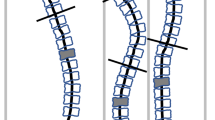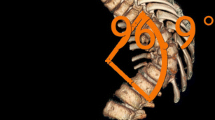Abstract
Purpose
Radiological measurement has been accepted as the gold standard for evaluating scoliosis for many years. However, exposure of children to X-ray constitutes a major limitation of the radiological methods. Spinal Mouse (SM) is a safe, practical and easy to perform measurement of curvature in scoliosis, but its validity and reliability have not been investigated. The aim of this study was to investigate the validity and reliability of Cobb angle and SM measurements in children with adolescent idiopathic scoliosis (AIS).
Methods
Fifty-one patients with AIS who were followed up conservatively were included in the study. The mean age of the patients was 14.4 years (9–18 years). Frontal plane curvatures were evaluated with SM by 2 physiotherapists and the results were compared with radiological measurements. Radiological measurements were performed by 2 orthopedists.
Results
All the measurements were of the thoraco-lumbar curve and the mean value was 35.08° according to Cobb angle measurement. There was no difference between the interobserver measurements of SM (p = 0.256) while the Cobb degrees measured by the 2 orthopedists was different (p = 0.0001). We did not find a statistically significant difference between Cobb measurements and the SM measurements of observer 1 and 2 (p = 0.505). The interobserver and intraobserver agreement of the Cobb and SM measurements was excellent (ICC = 0.872–0.962). When the differences between the evaluations were compared, the interobserver SM differences were seen to be lower than the interobserver Cobb angle differences (p = 0.003). The agreement between the Cobb and SM measurements was higher for curves over 40°. We found a strong or very strong relationship between measurements made with the Cobb and SM methods (p < 0.0001).
Conclusions
We conclude that SM can be used for research and patient follow-up in the clinic as a safe, reliable, quick, and easy to use method with no side effects although it cannot be the only factor to consider when determining the treatment plan of AIS patients.





Similar content being viewed by others
References
Asher MA, Burton DC (2006) Adolescent idiopathic scoliosis: natural history and long term treatment effects. Scoliosis 1(1):2
Beekman CE, Hall V (1979) Variability of scoliosis measurement from spinal roentgenograms. Phys Ther 59(6):764–765
Delorme S, Petit Y, De Guise JA et al (2003) Assessment of the 3-D reconstruction and high-resolution geometrical modeling of the human skeletal trunk from 2-D radiographic images. IEEE Trans Biomed Eng 50(8):989–998
Doody MM, Lonstein JE, Stovall M et al (2000) Breast cancer mortality after diagnostic radiography: findings from the US Scoliosis Cohort Study. Spine 25(16):2052–2063
Fleiss RJ, Menke JM (2001) Functional Rating Index: a new valid and reliable instrument to measure the magnitude of clinical change in spinal conditions. Spine 26(1):78–86
Fortin C, Feldman DE, Cheriet F, Labelle H (2010) Validity of a quantitative clinical measurement tool of trunk posture in idiopathic scoliosis. Spine 35(19):988–994. doi:10.1097/BRS.0b013e3181cd2cd2
Goldberg MS, Mayo NE, Levy AR et al (1998) Adverse reproductive outcomes among women exposed to low levels of ionizing radiation from diagnostic radiography for adolescent idiopathic scoliosis. Epidemiology 9(3):271–278
Goldberg MS, Poitras B, Mayo NE et al (1988) Observer variation in assessing spinal curvature and skeletal development in adolescent idiopathic scoliosis. Spine 13(12):1371–1377
Greiner KA (2002) Adolescent idiopathic scoliosis: radiologic decision-making. Am Fam Physician 65(9):1817–1822
Gstoettner M, Sekyra K, Walochnik N et al (2007) Inter-and intraobserver reliability assessment of the Cobb angle: manual versus digital measurement tools. Eur Spine J 16(10):1587–1592
Hattori T, Sakaura H, Iwasaki M et al (2011) In vivo three-dimensional segmental analysis of adolescent idiopathic scoliosis. Eur Spine J 20(10):1745–1750. doi:10.1007/s00586-011-1869-4
Ille´s T, Somoskeo¨y S (2013) Comparison of scoliosis measurements based on three-dimensional vertebra vectors and conventional two-dimensional measurements: advantages in evaluation of prognosis and surgical results. Eur Spine J 22:1255–1263. doi:10.1007/s00586-012-2651-y
Kellis E, Adamou G, Tzilios G et al (2008) Reliability of spinal range of motion in healthy boys using a skin-surface device. J Manipulative Physiol Ther 31(8):570–576. doi:10.1016/j.jmpt.2008.09.001
Knott P, Mardjetko S, Nance D et al (2006) Electromagnetic topographical technique of curve evaluation for adolescent idiopathic scoliosis. Spine 31(24):911–915
Levy AR, Goldberg MS, Mayo NE et al (1996) Reducing the lifetime risk of cancer from spinal radiographs among people with adolescent idiopathic scoliosis. Spine 21(13):1540–1547
Loder RT, Spiegel D, Gutknecht S et al (2004) The assessment of intraobserver and interobserver error in the measurement of noncongenital scoliosis in children ≤10 years of age. Spine 29(22):2548–2553
Loder RT, Urquhart A, Steen H et al (1995) Variability in Cobb angle measurements in children with congenital scoliosis. J Bone Joint Surg Br 77(5):768–770
Mangone M, Raimondi P, Paoloni M et al (2013) Vertebral rotation in adolescent idiopathic scoliosis calculated by radiograph and back surface analysis-based methods: correlation between the Raimondi method and rasterstereography. Eur Spine J 22:367–371. doi:10.1007/s00586-012-2564-9
Mannion AF, Knecht K, Balaban G et al (2004) A new skin-surface device for measuring the curvature and global and segmental ranges of motion of the spine: reliability of measurements and comparison with data reviewed from the literature. Eur Spine J 13(2):122–136
Morrissy RT, Goldsmith GS, Hall EC et al (1990) Measurement of the Cobb angle on radiographs of patients who have. J Bone Joint Surg Am 72(3):320–327
Ovadia D, Bar-On E, Fragniere B et al (2007) Radiation-free quantitative assessment of scoliosis: a multi-center prospective study. Eur Spine J 16(1):97–105
Parent S, Labelle H, Skalli W et al (2002) Morphometric analysis of anatomic scoliotic specimens. Spine 27(21):2305–2311
Pearcy M (1986) Measuring of back and spinal mobility. Clin Biomech 1(1):44–51. doi:10.1016/0268-0033(86)90037-9
Pearsall DJ, Reid JG, Hedden DM (1992) Comparison of three noninvasive methods for measuring scoliosis. Physical Ther 72(9):648–657
Post RB, Leferink VJM (2004) Spinal mobility: sagittal range of motion measured with the Spinal Mouse: a new non-invasive device. Arch Orthop Trauma Surg 124(3):187–192
Pruijs JE, Hageman MA, Keessen W et al (1994) Variation in Cobb angle measurements in scoliosis. Skeletal Radiol 23(7):517–520
Reamy BV, Slakey JB (2001) Adolescent idiopathic scoliosis: review and current concepts. Am Fam Physician 64(1):111–116
Ripani M, Di Cesare A, Giombini A et al (2008) Spinal curvature: comparison of frontal measurements with the Spinal Mouse and radiographic assessment. J Sports Med Phys Fitness 48(4):488–494
Saad KR, Colombo AS, Ribeiro AP et al (2012) Reliability of photogrammetry in the evaluation of the postural aspects of individuals with structural scoliosis. J Bodyw Mov Ther 16(2):210–216. doi:10.1016/j.jbmt.2011.03.005
Salisbury PJ, Porter RW (1987) Measurement of lumbar sagittal mobility a comparison of methods. Spine 12(2):190–193
Stokes IA, Bevins TM, Lunn RA (1987) Back surface curvature and measurement of lumbar spinal motion. Spine 12(4):355–361
Vidal C, Ilharreborde B, Azoulay R (2013) Reliability of cervical lordosis and global sagittal spinal balance measurements in adolescent idiopathic scoliosis. Eur Spine J 22:1362–1367. doi:10.1007/s00586-013-2752-2
Conflict of interest
None.
Author information
Authors and Affiliations
Corresponding author
Rights and permissions
About this article
Cite this article
Livanelioglu, A., Kaya, F., Nabiyev, V. et al. The validity and reliability of “Spinal Mouse” assessment of spinal curvatures in the frontal plane in pediatric adolescent idiopathic thoraco-lumbar curves. Eur Spine J 25, 476–482 (2016). https://doi.org/10.1007/s00586-015-3945-7
Received:
Revised:
Accepted:
Published:
Issue Date:
DOI: https://doi.org/10.1007/s00586-015-3945-7




